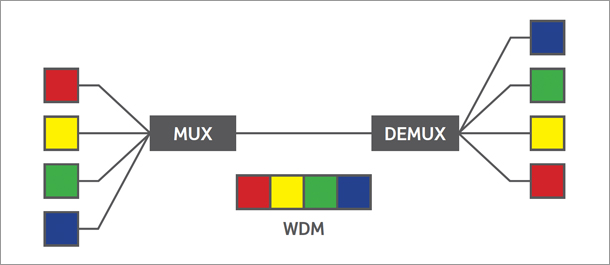5 Things to be Aware of with WBMMF

Mike Connaughton, Berk-Tek Data Center Market Segment Manager, and Gary Bernstein, Leviton Senior Director of Project Management, Fiber and Data Center, answer five common questions about new wideband multimode fiber (WBMMF) technology.
What is WBMMF?
WBMMF is a new fiber designed to carry multiple short wavelength signals that can be aggregated for high bandwidth applications — a technology known as wave division multiplexing (WDM). The fiber geometry will stay the same as existing OM3/OM4 fibers, with a 50 µm core and 125 µm cladding. Therefore, WBMMF will be physically compatible with existing multimode fiber connectivity.
The plan is to be able to transmit up to four wavelengths near the traditional 850 nm operating wavelength (also known as the "short" wavelength). This will at least quadruple the current information carrying capacity of multimode fiber. Figure 1 shows the plan to transmit 4x25 Gbps resulting in a 100 Gbps link across a single pair of multimode fibers terminated with LC connectors.

Figure 1: With WDM, a multiplexer joins signals together at the transmitter, and a demultiplexer splits them apart at the receiver, with the signal carried over WBMMF.
Is it a standards-based product?
The TIA TR42.12 working group aims to standardize the optical fiber. Both Leviton and Berk-Tek are active members of this committee. The TIA-492AAAE standard has been under development since early 2015 and is expected to be completed by the end of 2016. This has been (and may continue to be) a contentious project due to the active interest of many parties. When the TIA project is completed, IEC will take up the project for the international standards. At this point, IEEE does not recognize multi-wavelength transmission around 850 nm, but multiple transceiver vendors are producing products that comply with existing MSAs (multi source agreements).
Will it be successful?
Ultimately, the market will decide whether or not WBMMF will be successful. But the technology definitely shows promise. The early success of the 40G BiDi transceiver from Cisco is an example of a non-standards based option that can utilize this technology. Avago and Finisar have both released transceivers that operate at multiple wavelengths between 850 nm and 950 nm. Several companies have banded together to form the Short Wavelength Division Multiplexing (SWDM) Alliance to promote applications based on this technology. The SWDM Alliance is focused first on 40 Gbps (using four 10 Gbps wavelengths) and then on 100 Gbps (using four 25 Gbps wavelengths).
What is Berk-Tek Leviton Technologies' position on WBMMF?
As mentioned, the standardization effort has been contentious. In our opinion, there are several significant issues that should be resolved before we can confidently recommend installing this product. Among these issues are:
- Backwards compatibility with optical performances specified for OM4
- Installed testing parameters for the new operating wavelengths
- Assured interoperability between multiple vendors
The TEK Center at Berk-Tek is working with WBMMF products from multiple vendors so we can assure our customers that solutions will work as expected. Berk-Tek and Leviton are active members of the standardization process and are ready to deliver products to the market once we are satisfied that the solution is reliable.
Will it be called OM5?
The short answer is "probably." Even though TIA is working on the performance standard, it is IEC that owns the "OM" nomenclature. At this point, IEC does not have a project open to look at this particular product, but it is anticipated that IEC will harmonize with the TIA performance. Once that is complete, it seems likely that the product will be identified as OM5, but that is not certain.


